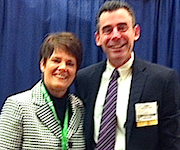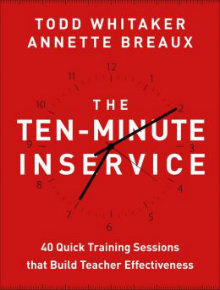10 Secrets of Successful Inservice Presentations

Busy school leaders need an easy-to-apply resource to increase teacher effectiveness quickly and efficiently. We wrote our book The Ten Minute Inservice to help principals, instructional coaches, teacher leaders and other staff developers to improve teaching school-wide through high-impact professional learning experiences lasting only ten minutes—incorporated easily into weekly staff meetings.
In the book, we offer 40 teacher-tested, mini-workshops that cover a range of topics, from behavior challenges and parent engagement to motivating students and making lessons meaningful.
In the concluding section we share a 10-point checklist that can help ensure succcessful inservice presentations, whatever the topic.
1. Be enthusiastic. Your enthusiasm can make or break a presentation. If you’ve ever attended an inservice presented by a less than enthusiastic presenter, you know this to be true. Regardless of the content and the speaker’s knowledge, a lackluster presenter will lose his audience every time. After all, if the speaker doesn’t seem to buy what he’s selling, why should the audience?

3. Prepare! No matter how long you have been presenting, you cannot “wing it” – not successfully, anyway. Audiences can always tell when a presenter is or is not prepared. Although you don’t want to read from a script, you do want to have an outline that is well prepared and that will keep you on point with your message. Practice your presentation beforehand. In this case, the mirror is your friend. Practice delivering your content, practice varying your tone of voice when you make specific points, and practice using positive body language! You want to come across as well prepared, approachable, believable, positive, passionate, and confident.

5. Make eye contact! Effective presenters speak directly to the audience, deliberately attempting to make eye contact with each attendee. This helps each person to feel as though the speaker is speaking directly to him or her, cementing that oh-so-important personal connection between “teacher” and “students.”
6. Laugh! Effective presenters know the importance of injecting humor into their presentations. They want the audience to enjoy the presentation and to feel at ease. An occasional funny story or corny joke can help accomplish this.
7. Involve your audience. Be careful not to talk “at” your audience. From start to finish, you want audience participation. That participation can take on many forms – discussions, questions, activities, and so on. An engaged audience is much more likely to absorb the ideas and information you are sharing.

9. Make the lessons you teach simple and doable. When you present information in a way that seems simple and doable, the audience is more apt to listen intently, consider the information you are sharing, and attempt to implement the new ideas, tips, and strategies you have shared in your presentation. If, in contrast, something you share seems difficult or time-consuming, your audience will quickly go into “overwhelm mode” and disconnect. So teach in small bites, just as effective teachers do in the classroom. You want your audience leaving you thinking, “I can do this!”
10. Ask for feedback, and use the feedback. Let your audience know that what they think matters! Address all of their comments with thoughtfulness and appreciation, even in the event that the comment is disagreeable.
________
[Adapted from The Ten-Minute Inservice: 40 Quick Training Sessions That Build Teacher Effectiveness by Todd Whitaker & Annette Breaux (Jossey-Bass/Wiley, San Francisco, CA . 2013.]

Todd Whitaker is a professor of educational leadership at Indiana State University and a prominent education author and speaker. Whitaker has taught at the middle and high school levels, served as a secondary school principal for eight years and as a district-level middle school coordinator. His many books include Leading School Change, What Great Principals Do Differently, What Great Teachers Do Differently and The 10-Minute Inservice. Follow him on Twitter @ToddWhitaker.


































